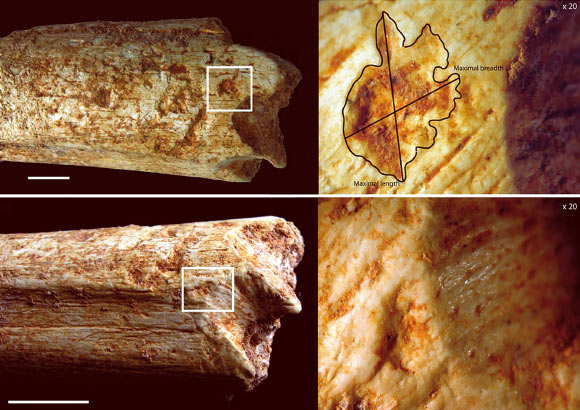According to a team of scientists headed by Dr. Jean-Jacques Hublin at the Max Planck Institute for Evolutionary Anthropology in Leipzig, Germany, tooth-marks on a femur bone of Homo heidelbergensis found in Morocco indicate that it was consumed by large carnivores, likely hyenas (Crocuta crocuta or Hyaena hyaena).

Life reconstruction of a Plio-Pleistocene hyena species, Chasmaporthetes gangsriensis. Image credit: Julie Selan.
During the Middle Pleistocene, human ancestors likely competed for space and resources with large carnivores, who occupied many of the same areas.
However, to date, little evidence for direct interaction between them in this period has been found.
“In the early Middle Pleistocene (up to 500,000 years ago) of North Africa, successful large predators such as the saber-tooth cat Homotherium, lived alongside leopards and lion-sized felids. These large cats were associated with increasingly modern canids and hyenids, which were effective hunters and carcass consumers,” said Dr. Hublin and his colleagues from Morocco, France and Germany.
“At that time, hyenids largely dominated carnivore spectra in caves as in open-air sites, whereas large canids remained rare, unlike in the European carnivore guild, jackals and foxes being more common. All these carnivores alternately occupied the living spaces with hominins and exploited the hunted or scavenged resources brought by their competitors.”
Dr. Hublin and co-authors examined the shaft of a femur from the skeleton of Homo heidelbergensis, found in the Moroccan cave ‘Grotte à Hominidés’ near Casablanca, and found evidence of consumption by large carnivores.
They said: “the bone was discovered in Unit 4 of the Grotte à Hominidés, dated to 500,000 years ago, and was associated with Acheulean artifacts and a rich mammalian fauna.”
The team’s examination of the bone fragment revealed various fractures and tooth marks indicative of carnivore chewing, including tooth pits as well as other scores and notches.
These were clustered at the two ends of the femur, the softer parts of the bone being completely crushed.
The marks were covered with sediment, suggesting that they were very old.

Carnivore marks on the distal end of the Homo heidelbergensis femur. Image credit: Camille Daujeard.
While the appearance of the marks indicated that they were most likely made by hyenas shortly after death, it was not possible to conclude whether the bone had been eaten as a result of predation on the hominin or had been scavenged soon after death.
Nonetheless, this is the first evidence that early humans were a resource for carnivores during the Middle Pleistocene in this part of Morocco, and contrasts with evidence from nearby sites that humans themselves hunted and ate carnivores.
“Depending on circumstances, hominins at this time could have both acted as hunter or scavenger, and been targeted as carrion or prey,” the scientists said.
The findings were published this week in the journal PLoS ONE.
_____
Daujeard C. et al. 2016. Pleistocene Hominins as a Resource for Carnivores: A c. 500,000-Year-Old Human Femur Bearing Tooth-Marks in North Africa (Thomas Quarry I, Morocco). PLoS ONE 11 (4): e0152284; doi: 10.1371/journal.pone.0152284







